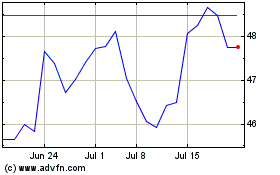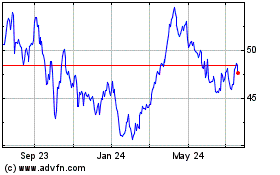By Erin Ailworth
Some of America's biggest shale producers are beginning to
ratchet back oil and gas production for the first time in years,
bending to the reality that a global glut will keep prices
depressed.
The production cuts, announced as shale companies reported
dismal earnings in recent days, stand in stark contrast to the past
year, when many U.S. drillers kept the taps turned on even as oil
prices plunged from nearly $100 a barrel to about $30. American oil
satisfies 10% of the world's daily needs, putting U.S. production
on par with output from Russia and Saudi Arabia.
The Organization of the Petroleum Exporting Countries continues
to at pump full tilt, further pressuring higher-cost operators such
as U.S. shale producers. Last week, Saudi Arabia oil minister Ali
al-Naimi bluntly told a roomful of energy executives in Houston
that the supply problem will only be resolved when low prices force
companies to stop producing the oil that is most expensive to
extract and sell.
So after years of boosting oil and gas flows across Oklahoma,
Texas and North Dakota, Continental Resources Inc., Devon Energy
Corp. and Marathon Oil Corp. say they plan to pull roughly 10% less
from the ground in 2016 than they did last year. EOG Resources Inc.
joined the chorus Friday, telling investors it has curbed
production and expects to pump 5% less oil this year.
One hurdle to throttling back production in the U.S. is that
shale drillers have become more efficient, tapping wells faster,
for less money, and coaxing more fuel out of each one. But other
companies have been forced to keep pumping just to bring in cash so
they could make interest payments on their heavy debt loads, or to
satisfy lease obligations.
EOG, which lost money last year for the first time, is
considered by many analysts to be the most efficient shale operator
in the U.S. Chief Executive Bill Thomas said the company would only
pump wells that give it a high rate of return--at least 30%--when
U.S. crude sells for $40 a barrel.
One way companies are trying to put a lid on production this
year is by waiting to pump wells they have already drilled. That
trend is creating a large inventory of oil and gas wells that will
be ready to turn on when crude prices finally do rebound.
Both Continental and rival Whiting Petroleum Corp. say they
won't pump much crude from new wells in North Dakota's Bakken Shale
this year. Continental still plans to drill a few new prospects,
but won't start pumping oil from many of them this year. It expects
to have a backlog of 195 drilled-but-uncompleted wells in North
Dakota this year. Similarly, Whiting said it would have 73 such
wells by year-end.
"We just don't want to bring anything else on in this
environment until we see a recovery happen," Continental Chief
Executive Harold Hamm told analysts and investors on a call last
week.
Once the biggest oil producer in North Dakota, Whiting lost $2.2
billion in 2015, mostly because it had to partially write down the
value of a field in Texas. The company, which brought in $2 billion
in revenue last year, is cutting its 2016 budget by 80%.
More than three dozen energy companies have collectively gutted
their budgets by nearly 50% on average in recent weeks, dialing
back spending for the year by roughly $36 billion when compared
with 2015.
"They're being forced to cut," said David Tameron, an energy
analyst at Wells Fargo Securities. "When you cut spending,
naturally production goes down."
IHS, the consulting firm that held the energy gathering in
Houston last week, is forecasting that U.S. oil output could fall
from more than 9 million barrels a day to as little as 8.3 million
barrels a day by this summer.
If that drop does materialize, it could boost crude prices back
to the $40-a-barrel range, according to IHS.
One risk, though, is that as prices move higher, some producers
may be tempted to turn on the spigot once again, a move that could
in turn drive prices back down.
That happened last spring when prices popped back to $60 a
barrel, spurring producers to race back into oil fields and tap new
wells.
If that happens, prices could collapse even below current
levels, said Jamie Webster, senior director of oil markets for
IHS.
"It wouldn't surprise me if it were single digits," Mr. Webster
said of the potential for oil prices to fall below $10 a barrel if
U.S. producers decide to drill more.
Some companies, particularly those that have hedged against
falling prices, are bucking the trend. Pioneer Natural Resources
Co., which drills in West Texas, still plans to boost production at
least 10% this year thanks in part to hedging contracts that give
it above-market prices for much of the crude it pumps.
"We have good hedges, we have a great balance sheet, and still
good returns," said Scott Sheffield, Pioneer's chief executive.
Jim Teague, who runs Enterprise Products Partners LP, one of the
biggest pipeline companies in the U.S., said he can't predict how
long the pain in the oil patch will last.
"I don't have a clue how low crude oil is going to go, how long
it's going to stay there, or what normal's going to look like" when
things finally stabilize, he said. "People keep calling it a cycle.
I call it pure hell."
--Alison Sider and Dan Molinski contributed to this article.
Write to Erin Ailworth at Erin.Ailworth@wsj.com
(END) Dow Jones Newswires
February 29, 2016 20:33 ET (01:33 GMT)
Copyright (c) 2016 Dow Jones & Company, Inc.
Devon Energy (NYSE:DVN)
Historical Stock Chart
From Mar 2024 to Apr 2024

Devon Energy (NYSE:DVN)
Historical Stock Chart
From Apr 2023 to Apr 2024
